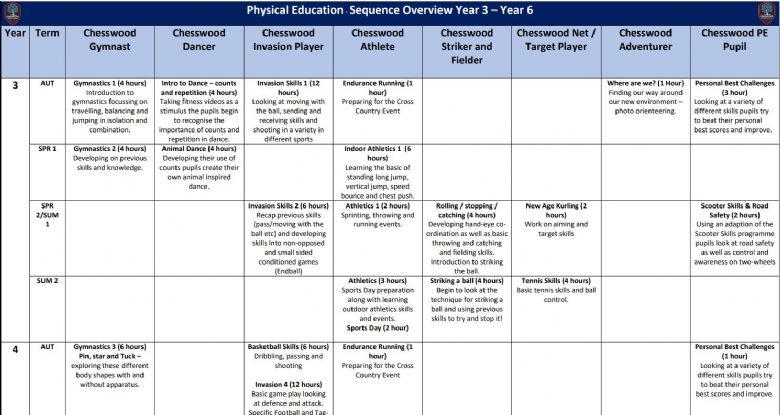PE Curriculum Content and Sequence
PE SEQUENCE OVERVIEW
To download the full PE Sequence Overview please click on the image below
PE Vision
Through the teaching of Physical Education, children will learn how to become confident, creative and physically active pupils with a clear understanding of a healthy lifestyle. Pupils will develop the ability to work as part of a team/group, manage and control risks, confidently and competently use a variety of sporting equipment and rules; as well as create and perform routines in front of an audience. Children will understand clear links between their learning and real life – understanding how their developing knowledge and skills can be applied today, beyond school and in to adult life, including potential career paths within the sporting field.
Learning will be focused on the following strands – invasion games, athletics, gymnastics, dance, striking and fielding, problem solving, swimming and net games with an overriding them of healthy lifestyles. Children will be inspired by individuals, both historically and current, exposing them to the best of what has been thought, said and achieved in these areas. Through the evaluation of performance and self-challenge children will develop resilience within physical activity giving all the chance to succeed.
Although physical education is a highly practical subject, learning will be underpinned by core knowledge, skills, concepts and vocabulary on which children will have the confidence to be more creative, making more informed decisions when playing and performing.
PE principles
In line with the whole school curriculum policy, the following drivers and principles underpin everything we do in PE.
Curriculum Drivers
Life Opportunities Creativity, Confidence, Competence
Curriculum Principles
Balanced Coherent Real & Relevant
Knowledge Rich Cognitively Challenging Inclusive
pe strategy
Life Opportunities
Life skills are key to physical education at Chesswood. The balanced curriculum allows children to experience a wealth of different physical activities as well as different roles with sports. Real life opportunities are sought, inviting in professional sports stars to show the pinnacle of sport as well as more local sporting heroes shows where sport can lead.
Developing the ability to work within a team and understand different strengths and weakness of others and themselves.
Within physical education we have different leadership roles which give the children experience of managing and organising events and other pupils.
ACRO In Action job profiles will form part of key learning in each area.
Creativity Confidence Competence
Chesswood physical education curriculum is designed to build knowledge and skills upon skills, sequencing progression through the school. This seeks to embed creativity, competence and confidence within the subject. Many aspects of the curriculum are based around local sporting competitions and festivals to prepare the children to be competent when they enter them. Creativity is shown within the bi-annual Dancemania school dance festival and when our Y6 pupils host Mini-Olympics as a transition for our upcoming Y2 pupils. Within lessons such as gymnastics and dance there is the chance for all children to show creativity and perform to peers.
Balanced
Physical Education is taught for 2 hours each week in all year group during curriculum time with many additional opportunities outside the core teaching time. Within each year pupils will have the opportunity to develop progressing skills and knowledge in games (invasion/striking and fielding), gymnastics, dance, athletics as well as their ability to analyse their own and the performance of others. Swimming takes part in a specific year group.
Coherent
Whilst making links to various other subjects most notably Maths, Science and English, the place and importance of physical education is the core focus. Knowledge, skills, concepts and vocabulary in physical education are coherently planned and sequenced progressively. There is clarity about what getting better at the subject means, with the aim of moving children from novice to expert. The physical education leader has autonomy to build and oversee the PE curriculum, ensuring they have a full understanding of the progressive journey children have through the units planned.
Real and Relevant
Within PE real and relevant experiences are plentiful as many units are linked to events and competitions happening within the local community. The school has many local club links to help with pathways to new opportunities for all seeking them. Highlighting successes from ex-pupils, local and national sporting teams and performers gives pupils something to aspire to.
Knowledge Rich
The PE curriculum seeks to sequence skills and knowledge effectively, ensuring that children have a good understanding of core knowledge to enable them to progress from unit to unit. Core knowledge and skills (procedural knowledge) are specified in detail and laid out in knowledge organisers for the key strands within physical education.
Cognitively Challenging
Units are chosen specifically to stretch children’s knowledge and skills development, with a key focus on core technical vocabulary and understanding of sporting principles and evaluation/analysis.
Inclusive
The Physical Education curriculum is constructed in a way that is ambitious and designed to give all learners, particularly the most disadvantaged and those with special educational needs and/or disabilities (SEND) or high needs, the knowledge and cultural capital they need to succeed in life. Units have been designed to support the development of key life skills which can be used by all pupils in everyday life. For example - teaching first aid, linked to survival in Y5 and road safety in Y3. The knowledge and skills foci seek to overcome barriers of the varied life experiences of children at Chesswood. The schools also actively seek opportunities to represent the school within a team or a group for disadvantaged children.

